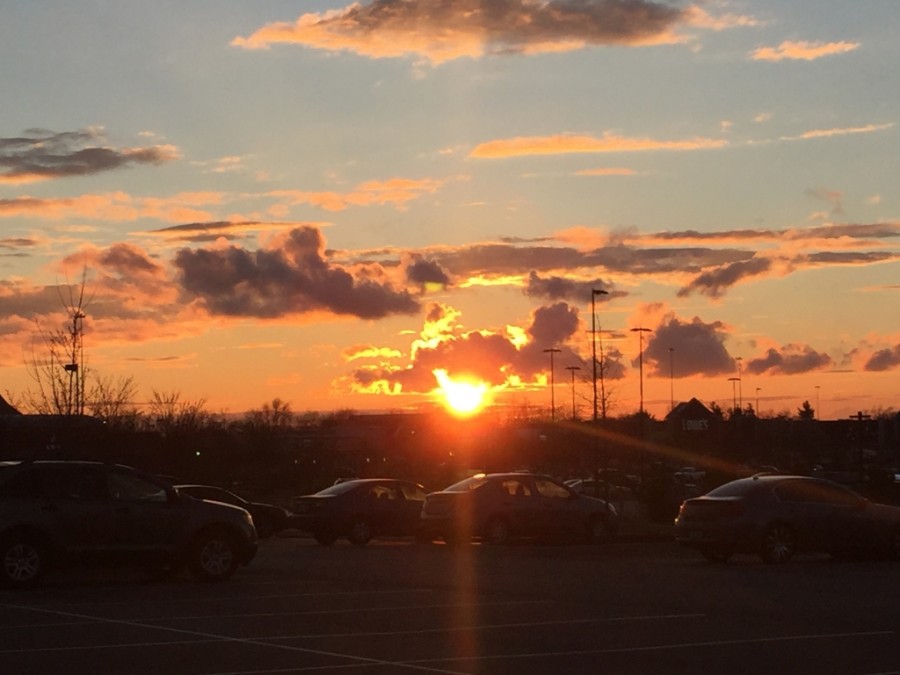Under the Beauty of Glowing Sunsets Lies an Ugly Cause
A beautiful sunset in Louisville hides a darker secret of pollution.
March 30, 2016
With the spring’s one-hour shift forward, sunrise in Louisville occurs about 7:45 a.m. With the rise of the sun above the horizon comes a mix of colors that look like a beautiful canvas. At least that is how it looks on the surface. Air pollution plays a significant role in the appearance of sunrises and sunsets in our city.
Some aspects of nature lead to the fiery glow of a sunset, among them forest fires, minerals in the air, volcanic eruptions and other natural factors; however, since there are no volcanic eruptions or forest fires in Louisville, the causes of glowing sunsets and sunrises are man made. The direct cause is air pollution or smog.
According to the EPA, “Smog occurs when emissions from industry, motor vehicles, incinerators, open burning and other sources accumulate under certain climatic conditions.” These emissions create a layer in the atmosphere. This is why when the sun is setting or rising, a reddish-orange color can be seen.
A sky not full of burnt fossil fuels would look more blue or violet. We do not see these reddish hues in the sky when the sun is at its peek because the rays are separated equally; however, during sunset all of the sun’s remaining rays are focused on the layer of smog, literally “shedding light” on air pollution in our city.
According to WDRB chief meteorologist Marc Weinberg, “Air pollution by nature is impacted by the weather, and one could say it controls the air quality. When we have stagnant weather patterns with little to no wind, the atmosphere doesn’t mix, and the pollutants stay in the lowest part of the atmosphere where we live. This is why the hot and quiet summer days tend to have the worst air quality. On windy winter days, the air is mixed up so well that none of the pollutants can sit in the lower atmosphere and affect us. The bottom line is, it would be more accurate to say the weather has a significant effect on the impact pollutants can have on our air quality.”
Weinberg, who has been a meteorologist for 18 years, said the weather patterns haven’t changed since he started working on TV, but if air pollution gets worse, we could see some drastic changes in our weather and air quality.
Weinberg said, “We know that the pollutants can change, and in that, it will make those summer months more prone to air quality issues. I do not believe we are on a course to add enough pollutants to affect winter months, but summer months absolutely could become worse if we do not curb pollutants and emissions that can be unhealthy to humans. I don’t think there is a meteorologist alive that doesn’t think protecting our atmosphere is a wise move.”
The EPA has deemed six major air pollutants to be the most harmful to the public, setting national standards that every community must meet. The six major pollutants are carbon monoxide, lead, oxides of nitrogen, sulfur dioxide, ozone, and particulate matter. These pollutants come from industry and transportation (cars, trucks, planes, boats, and construction equipment).
Air pollution is a health hazard to all citizens, but it is most impactful on senior citizens, young children, and people with breathing ailments like asthma, chronic obstructive pulmonary disease and emphysema.
The Air Pollution Control District of Louisville plays a huge role in the containment and regulation of air pollution in the city.
Thomas Nord, communications specialist for the Air Pollution Control District of Louisville, commented on the APCD’s role in reducing air pollution.
“The APCD is delegated by the federal government to enforce the Clean Air Act in Louisville/Jefferson County,” Nord said. “Our primary job is to issue federally enforceable air pollution permits to local factories, power plants, and gas stations, then make sure that they are following all local, state, and federal air pollution laws and regulations.”
Nord emphasized that “air quality has improved. Carbon monoxide, lead, and oxides of nitrogen have been below federal standards for many years in Kentuckiana. Levels of sulfur dioxide (a pollutant primarily from coal-burning power plants), ozone, and PM have been problematic in the past decade, but they are also on the decline of late thanks to better emissions controls at local power plants and improvements in motor vehicle emissions controls.”
Nord pointed out that everyone plays a role in decreasing air pollution.
He said, “We also have a community compliance unit that enforces local odor and dust nuisance regulations. The APCD’s community outreach unit, Kentuckiana Air Education, encourages motorists to help the air by driving less, maintaining their vehicles, and reducing unnecessary engine idling.”
The APCD enacted the Strategic Toxic Air Reduction program after studies indicated high levels of toxic chemicals in the environment around the area known as Rubbertown.
Nord said, “The STAR program works to reduce the cancer risk caused by industrial chemicals, and is more protective than the standards set by the state of Kentucky and the federal government. It is considered a model program around the nation.”
A number of steps can be taken to reduce pollution throughout the communities, according to Nord.
He said, “On a personal level, people can lobby their local leaders for more ‘walkable’ communities, enhanced mass transit, and protection for the city’s tree canopy, which cools the city and helps mitigates air pollution. We also encourage energy efficiency at home, such as choosing appliances that use less electricity, setting the thermostat lower in winter and higher in summer, replacing drafty doors and windows, and just being more thoughtful about the way they use electricity.”
As pollution levels continue to drop, so will the number of glowing sunsets.



Dan Zoeller • Mar 30, 2016 at 2:20 pm
Really thoughtful and well written article. I hope your generation take up this challenge and leaves the world cleaner than mine has.